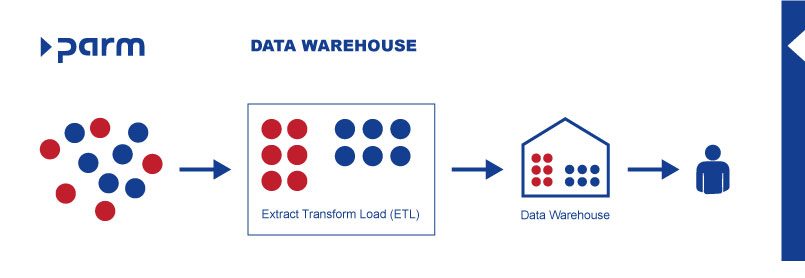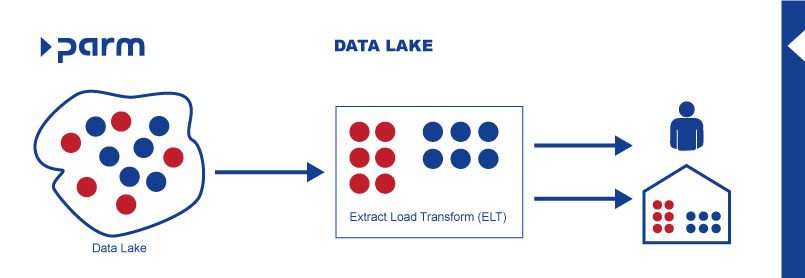Data Warehouse and Data Lake
Definition, similarities and differences

The amount of data collected in companies is constantly increasing and with it the need to optimally manage this data and use it for analyses. Data warehouses and data lakes are established solutions for storing large amounts of data. We explain the most important differences between the two options.
What is a Data Warehouse?
The term data warehouse refers to a central collection of data, usually as part of a business intelligence solution. A large amount of data from different sources can be collected and stored here. For this purpose, the data warehouse regularly extracts data from different systems, which is then validated, cleaned, formatted and compared with already existing information. Thus, a so-called ETL process (Extract, Transform, Load) takes place. For this, the structure of the data, the so-called schema, is determined first. This procedure is called Schema on Write and determines what consolidated data looks like. Since data is usually recorded in tables, the schema answers questions such as:
- What does a row in a table look like?
- What attributes does each row contain?
- What data is expected?
The resulting processed data is stored in such a way that users can access it at any time.

Advantages of Data Warehouses
- Easy analysis: Since the data in a data warehouse is available in a consistent format, it can be easily analysed in a BI system and therefore used for decision-making. Even users without data technology knowledge can thus draw important insights from the available data.
- Merging data: Since information from different databases is collected in a data warehouse, the data from different sources can be easily related to each other or analysed for correlations.
- Data quality: Since the data is validated and formatted before it is saved, the data warehouse contains only consistent and relevant data. The quality of the available data is therefore very high.
Disadvantages of Data Warehouses
- Missing data: In a data warehouse, only the data that was needed for the originally intended purpose is stored. If additional data is needed, it must be added to the data warehouse in a cumbersome way.
- Less flexibility: If the purpose of the data warehouse has changed or if more data is needed in the future, the data warehouse must be adapted. This is due to the fact that the data model or structure has been defined in advance (schema on write). Changing this can be time-consuming and costly. A data warehouse is therefore less flexible for new data sources.
- High start-up costs: Since the schema on write must be defined before starting with a data warehouse, higher costs are initially incurred.
What is a Data Lake?
A data lake refers to a central repository in which large amounts of data from various sources are stored, usually in raw format. But structured or semi-structured data can also be stored. So, while in a data warehouse only structured data is stored, data lakes can store information in different formats and make it available to the users in this way. In this case, the data model is only recorded in detail when the contents are read out (schema on read), which can be error-prone. An ELT process (Extract, Load, Transform) therefore takes place here.

Advantages of Data Lakes
- Accessibility: Company data is stored centrally in the data lake and can thus be easily accessed by all users.
- Avoidance of data silos: Both structured and semi-structured or unstructured data are stored. This avoids data silos.
- High flexibility: Data can be changed and shaped so that it can be analysed for different purposes. Additional data sources can be added easily and without major changes to the data lake.
- Machine learning: The stored data is ideal for machine learning.
Disadvantages of Data Lakes
- Storage capacity: Since all data is stored unfiltered, a larger memory is required than with the data warehouse.
- Data quality: Without measures for data quality and data governance, the stored data can quickly become a so-called Data Swamp. A data swamp is an unmaintained data lake in which data is stored without appropriate documentation, so that one quickly loses the overview.
Similarities and differences
Both data warehouses and data lakes are designed for business analyses and serve as central data storage in the company. Since their purpose and goals are similar, it is easy to confuse the two technologies. The main differences are:
| Data Warehouse | Data Lake | |
| Data structure | Structured, processed data | Structured and semi-structured data, but mainly raw data |
| Purpose of data storage | Defined, therefore smaller amount of data | Not defined, therefore larger amount of data |
| Users | Different users, mostly without data science knowledge | Data scientists or special tools needed to translate the data for other users |
| Changes complicated and costly | Data easily accessible, quick and easy to update | Data easily accessible, quick and easy to update |
| Schema | Schema on Write: Schema is defined before data is stored | Schema on Read: Schema is defined when data is read |
How to make the right choice
Whether a data warehouse or a data lake is the better choice for you depends on various factors, which may already be evident from the differences between the two technologies. Therefore, ask yourself:
- Should structured data or raw data be stored?
- Is the data to serve a specific purpose?
- Who will use the data?
- How likely is it that the evaluation requirements will change?
The Future: The Data Lakehouse
Often companies cannot make a clear decision whether they need a data warehouse or a data lake. Rather, they need both – a data lake to benefit from raw data, but also a data warehouse to provide analytics to all business users. However, running the two technologies at the same time has the disadvantage that the data is stored in two or more places, so it also has to be analysed, maintained and monitored in different places. This in turn can lead to errors or out-of-date data.
A data lakehouse combines the flexibility of data lakes with the structure-giving processes of a data warehouse and thus promises the best of both technologies. In this way, it is also possible to analyse unstructured data in a BI system, for example.
Conclusion
Data warehouses and data lakes are designed for business analyses. Both have their advantages and disadvantages, but they can also complement each other. The more suitable solution for managing your company data depends on your needs and various conditions.
The business intelligence software myPARM BIact is basically based on a data warehouse. This makes it possible for employees without data technology knowledge to analyse the stored data, create reports as well as diagrams and gain important insights from the data.
However, it is also possible to connect and analyse semi-structured data in myPARM BIact. But this requires a higher level of knowledge regarding the structure of the data model for analysing such data. This means that the expertise of a data scientist may be required.
Learn more about the Business Intelligence Software Software myPARM BIact:
Would you like to get to know myPARM BIact in a demo presentation? Then make an appointment with us right away!
